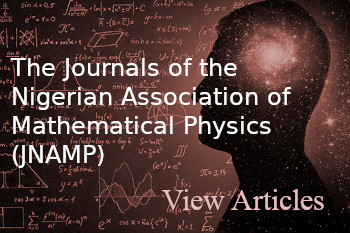THE ROLE OF MOSQUITO TRAP IN MALARIA CONTROL- A MATHEMATICAL APPROACH)
DOI:
https://doi.org/10.60787/tnamp-19-17-28Keywords:
Mosquito trap, Effectiveness, Host-vetor, Control, MalariaAbstract
We propose a simple mathematical model of malaria transmission involving a system of five ordinary differential equations with only susceptible and infectious classes of both humans and mosquitoes and a new class of trapped mosquitoes. The motivation is to use mathematical approach to analyze the role of mosquito trap in malaria control. We obtain the basic reproduction number, R0 and found that the trap effectiveness is a key parameter that drives the dynamics of the disease. The analytical results show that, for R0 < 1 , the disease-free equilibrium point is locally asymptotically stable and globally asymptotically stable in the absence of disease related death, and unstable for R0 > 1. We found from the numerical solution that with the given parameter values in the absence of mosquito trap, malaria infection may be as high as 80% within six months of introduction of few infected mosquitoes into an entirely susceptible population. Although, other parameters like the infection rates of both humans and mosquitoes can cause the disease to invade the population when the level of trap effectiveness is low but trap effectiveness very close to 1 may likely lead to disease eradication.
Downloads
References
WHO, World Malaria Report, 2021. [online]. [Viewed 10/06/2022] https://www.who.int/teams/global-malaria-programme/reports/world-malaria-report-2021
Institute of Medicine (US) Committee on the Economics of Antimalarial Drugs; Arrow K. J., Panosian, C., Gelband, H., editors. Saving Lives, Buying Time: Economics of Malaria Drugs in an Age of Resistance. Washington (DC): National Academies Press (US); 2004. 5, A Brief History of Malaria.
Thongsripong, P., Hyman, J. M., Kapan, D. D., Bennett, A. N. Human–Mosquito Contact: A Missing Link in Our Understanding of Mosquito-Borne Disease Transmission Dynamics, Annals of the Entomological Society of America, Volume 114, Issue 4, July 2021, Pages 397–414, https://doi.org/10.1093/aesa/saab011
Mandal, A., Sarkar, R. R., Sinha, S. Mathematical models of malaria - A reviewMalaria Journal. 2011;10(1):202: DOI:10.1186/1475-2875-10-202.
Cobremeskel, A. A., Krogstad, H. E. Mathematical modeling of endemic transmission. American journal of Applied Mathematics. 2015;3(2):36-46.
Mojeeb A., EL-Nor, I., Isaac, K. A. Simple Mathematical Model on Malaria Transmission. Journal of Advances in Mathematics and Computer Science. 2017; 25(6):1-24. DOI: 10.9734/JAMCS/2017/37843
First Malaria Vaccine – A Major Milestone Despite Huddles Ahead. WebMD. WebMD, 2 December 2021. Web. 30 May 2022.
Agusto F. B.,“Malaria drug resistance: The impact of human movement and spatial heterogeneity”, Bull. Math. Biol., 76 (2014), No. 7, 1607–1641. doi: 10.1007/s11538-014-9970-6 [ Links ]
Tchuenche J. M., Chiyaka C., Chan D., Matthews A. and Mayer G., “A mathematical model for antimalarial drug resistance”, Math. Med. Biol., 28 (2011), No. 4, 335–355. doi: 10.1093/imammb/dqq017 [ Links ]
Montoya, C., Romero–Leiton, J. P., Mathematical modelling for malaria under resistance and population movement. Integración - UIS [online]. 2020, vol.38, n.2, pp.133-163. Epub June 30, 2020. ISSN 0120-419X. https://doi.org/10.18273/revint.v38n2-2020006.
Aneke S., “Mathematical modelling of drug resistant malaria parasites and vector populations”, Math. Methods Appl. Sci., 25 (2002), No. 4, 335–346. doi: 10.1002/mma.291 [ Links ]
Ngonghala, C. N., Del Valle, S. Y., Zao, R., Mohammed- Awel, J., Quantifying the impact of decay in bed-net efficacy on malaria transmission. 2014; J of Theor Biol. 363, 247-261. Doi: 10.1016/j.jtbi.2014.08.018
Okrinya, A. B., Consul, J. L., Logistic mathematical model of Ebola virus disease with convalescence. International Journal of Applied Scientific and Research. 2(6) (2019), 1-14.
Okrinya, A. B., Timinibife C. N., Global Stability Analysis of a Mathematical Model on the Transmission Dynamics of Covid-19 with Vaccination. International Journal of Mathematics and Computer Research. 10 (12) (2022), 3039-3049. DOI: 10.47191/ijmcr/v10i12.06
Chitnis, N., Cushing, J. M. Hyman, J. M., Bifurcation analysis of a mathematical model or malaria transmission. SIAM J. Appl. Math. 67 (2006), 24-45.
Okrinya, A. B., Mathematical modelling of Malaria Transmission and Pathogenesis, PhD Thesis, Loughborough University, 2015.
Allen, L. J. S. (2007). An Introduction to Mathematical Biology, Prentice Hall, Upper Saddle River, N. J.
M. O. Onuorah, and N. I. Akinwande, (2016). Sensitivity analysis of Lassa fever model. European Centre for Research Training and Development UK. (www.eajournals.org).14(1)
B. M. Ndiaye, and L. S. Tendeng, (2020). Analysis of the COVID-19 pandemic by SIR model and machine learning techniques for forecasting. Available https://doi.org/10.48550/arXiv.2004.01574
BT. Chen, J. Rui, Q. Wang, Z. Zhao, J. Cui, L. Yin, (2020). A mathematical model for simulating the phase-based transmissibility of a novel coronavirus. Infectious Diseases of Poverty. 9(24). Available:https//doi.0rg/10.1186/s40249-020-00640-3.

Published
Issue
Section
License
Copyright (c) 2024 The Transactions of the Nigerian Association of Mathematical Physics

This work is licensed under a Creative Commons Attribution-NonCommercial 4.0 International License.




